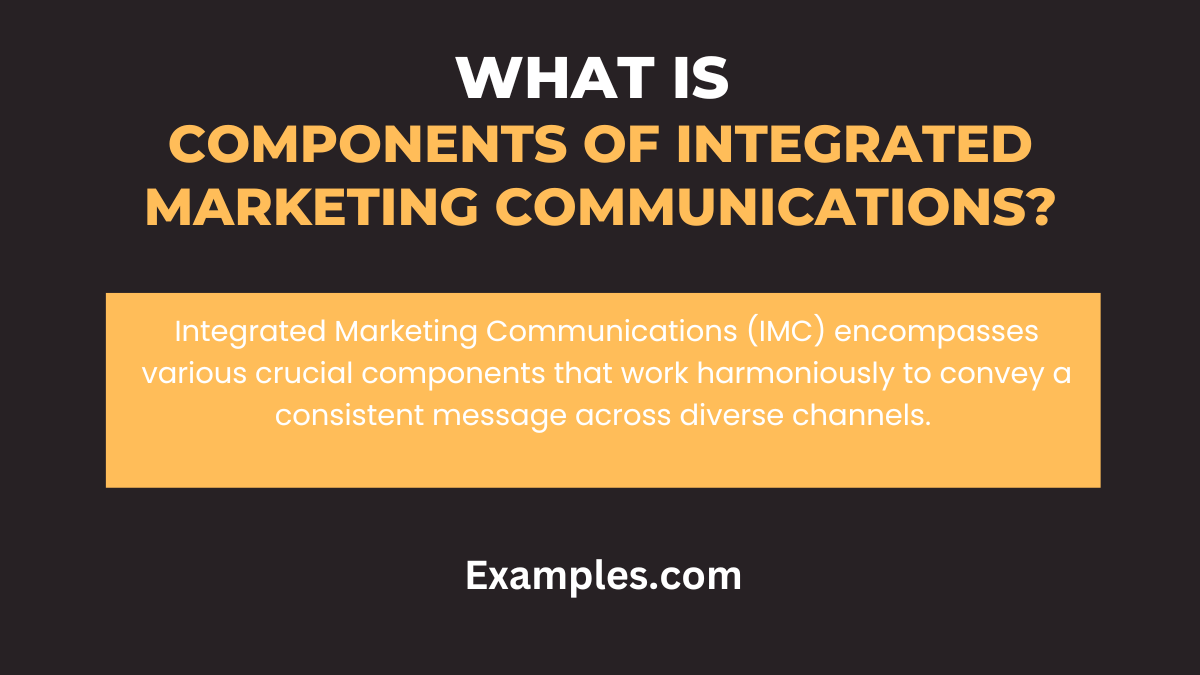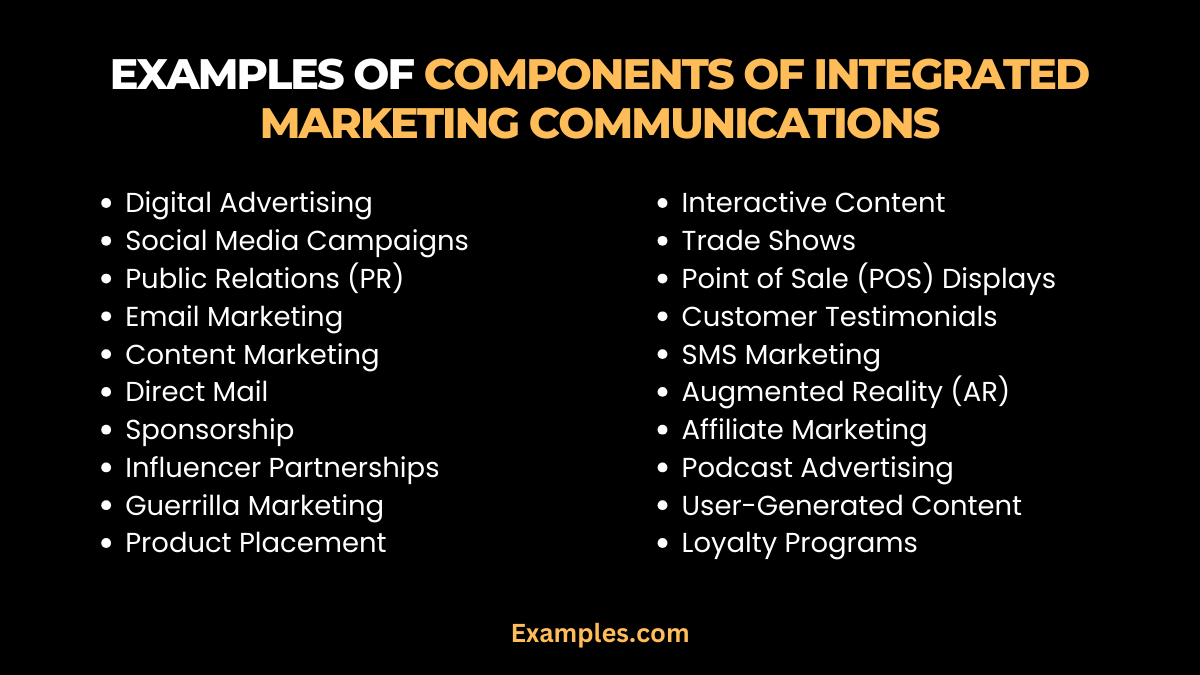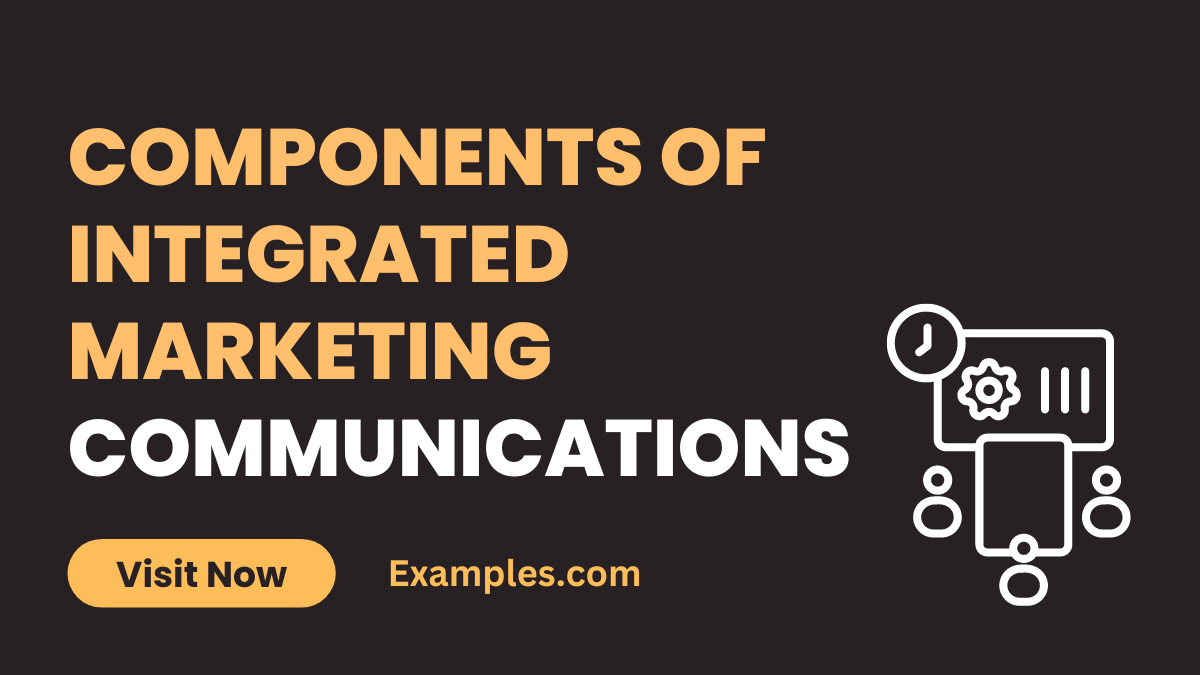19+ Components of Integrated Marketing Communications Examples
What is Components of Integrated Marketing Communications?

Integrated Marketing Communications (IMC) encompasses various crucial components that work harmoniously to convey a consistent message across diverse channels. At its core, IMC involves coordinating promotional efforts to ensure a unified brand image. This includes advertising, public relations, direct marketing, sales promotion, and digital marketing. By understanding these interconnected components, businesses can orchestrate comprehensive campaigns that resonate with their target audience. Explore the fundamental definition and intricate details of each component in this comprehensive guide.
20 Examples of Components of Integrated Marketing Communications

Crafting a successful Integrated Marketing Communications (IMC) strategy involves leveraging various components synergistically. Here are 20 exemplary instances:
- Digital Advertising: Using online platforms for targeted brand promotion and engagement.
- Social Media Campaigns: Leveraging platforms like Instagram and Facebook for interactive brand storytelling.
- Public Relations (PR): Cultivating positive media relations to enhance brand credibility.
- Email Marketing: Sending personalized messages to nurture leads and maintain customer relationships.
- Content Marketing: Creating valuable content to engage and educate the audience.
- Direct Mail: Sending physical promotional materials directly to consumers’ mailboxes.
- Sponsorship: Associating the brand with events or causes to enhance visibility.
- Influencer Partnerships: Collaborating with influencers for authentic brand endorsements.
- Guerrilla Marketing: Unconventional and creative approaches to capture audience attention.
- Product Placement: Integrating products seamlessly into TV shows, movies, or content.
- Interactive Content: Engaging audiences through quizzes, polls, and interactive materials.
- Trade Shows: Participating in industry events to showcase products and network.
- Point of Sale (POS) Displays: Strategically placing promotional materials at the point of purchase.
- Customer Testimonials: Showcasing positive feedback to build trust and credibility.
- SMS Marketing: Utilizing text messages for direct and instant communication.
- Augmented Reality (AR): Implementing AR elements for an immersive brand experience.
- Affiliate Marketing: Partnering with affiliates to promote products for a commission.
- Podcast Advertising: Reaching audiences through sponsored segments in popular podcasts.
- User-Generated Content: Encouraging customers to create content showcasing product experiences.
- Loyalty Programs: Rewarding customer loyalty with exclusive perks and incentives.
Importance of Integrated Marketing Communications

Integrated Marketing Communications (IMC) ensures a cohesive brand message across diverse channels, reinforcing brand identity and boosting audience engagement. It aligns marketing efforts, amplifying impact while maintaining consistency in messaging. This approach enhances brand recall and customer loyalty, fostering a unified brand experience across touchpoints.
- Apple’s Unified Messaging: Apple delivers consistent brand messaging across products, advertising, and customer service. How to Improve: Integrate customer feedback into marketing strategies for better alignment.
- Nike’s Holistic Branding: Nike seamlessly connects brand messaging in its advertising, sponsorships, and social media presence. How to Improve: Use customer data to personalize communication strategies effectively.
- Coca-Cola’s Unified Campaigns: Coca-Cola’s marketing harmonizes across ads, sponsorships, and packaging, maintaining a consistent brand image. How to Improve: Utilize analytics to refine communication strategies for better synergy.
- Google’s Cohesive Messaging: Google’s messaging remains consistent across search, advertising, and product launches. How to Improve: Optimize cross-channel interactions to enhance brand consistency.
- Amazon’s Integrated Branding: Amazon synchronizes its branding through its website, packaging, and advertising strategies. How to Improve: Streamline communication channels for seamless brand integration.
Integrated Marketing Communication in Public Relations
Integrated Marketing Communication (IMC) plays a pivotal role in shaping Public Relations (PR) efforts. PR involves managing an organization’s communication with its stakeholders, fostering positive relationships. By integrating IMC, PR strategies benefit from a cohesive approach across various channels.
- Digital Press Releases: What it is: Utilizing digital platforms to disseminate press releases and news stories.
Example: Airbnb’s digital press releases on partnerships and community initiatives. How to Improve: Enhance multimedia elements and shareable content for wider reach. - Crisis Communication Strategies: What it is: Coordinating PR efforts during crises to manage information and maintain reputation.
Example: Johnson & Johnson’s response during the Tylenol poisoning crisis. How to Improve: Simulate crisis scenarios for better-prepared responses. - Social Media Crisis Management: What it is: Integrating social media in crisis communication for real-time updates and engagement.
Example: Starbucks’ handling of the racial bias incident on social media. How to Improve: Implement monitoring tools for quicker response times. - Employee Advocacy Programs: What it is: Involving employees as brand advocates to enhance PR through internal communication.
Example: Microsoft’s “Microsoft Life” employee advocacy program. How to Improve: Provide training and incentives to boost employee engagement. - Influencer Collaborations: What it is: Partnering with influencers for authentic brand endorsements and positive PR.
Best Example: Nike’s collaboration with athletes for impactful PR. How to Improve: Select influencers aligned with the brand’s values for genuine partnerships.
What are the 6 Components of Integrated Marketing Communications?
Integrated Marketing Communications (IMC) involves synergizing various elements to create a cohesive and effective marketing strategy. Here, we delve into the six key components that form the foundation of a successful IMC approach:
- Advertising: Explore the power of paid promotional messages across diverse channels to maximize brand visibility.
- Public Relations (PR): Uncover the strategies involved in cultivating positive media relationships and managing the public perception of your brand.
- Direct Marketing: Learn how to reach your audience directly through targeted emails, direct mail, and other personalized communication methods.
- Sales Promotion: Discover the art of creating incentives and promotions to drive short-term sales and enhance brand loyalty.
- Personal Selling: Explore the impact of one-on-one interactions, allowing you to tailor your message to individual customers.
- Digital Marketing: Embrace the digital landscape, incorporating online channels such as social media, content marketing, and SEO into your comprehensive IMC strategy.
What Are The Components of Sales Promotion In Marketing Management?
Sales promotion is a crucial element of marketing management, encompassing various strategies to boost sales and engage customers. Understanding its components is essential for crafting effective campaigns. Let’s delve into the key elements of sales promotion:
- Discounts and Rebates:
- Explore the impact of offering discounts and cashback incentives.
- Implement strategic pricing strategies to attract cost-conscious consumers.
- Contests and Competitions:
- Create engaging competitions to captivate the audience.
- Analyze successful contest examples for inspiration and effectiveness.
- Sampling and Product Demonstrations:
- Examine the role of product sampling in introducing new products.
- Learn how effective product demonstrations can drive customer interest.
- Coupons and Vouchers:
- Understand the psychology behind coupon usage.
- Implement voucher systems effectively to drive both online and offline sales.
- Point-of-Purchase (POP) Displays:
- Explore the impact of strategically placed displays on consumer purchasing behavior.
- Learn how visual merchandising can enhance the overall shopping experience.
- Loyalty Programs:
- Analyze the benefits of customer loyalty programs.
- Understand how to design and implement effective loyalty initiatives.
- Referral Programs:
- Examine the power of word-of-mouth marketing through referral programs.
- Learn how to incentivize customers to refer friends and family.
- Flash Sales and Limited-Time Offers:
- Explore the psychological appeal of urgency in sales promotions.
- Implement effective flash sales and limited-time offers for maximum impact.
- Bundling and Package Deals:
- Understand the strategy behind bundling products.
- Learn how to create enticing package deals to increase average transaction value.
- Trade Promotions:
- Explore promotional activities targeted at retailers and distributors.
- Understand how trade promotions can impact supply chain dynamics.
In conclusion, mastering the components of integrated marketing communications opens avenues for crafting impactful strategies. From leveraging discounts to embracing interactive promotions, each element plays a vital role. By understanding and implementing these components strategically, marketers can navigate the dynamic landscape, fostering brand growth, engaging audiences, and driving sales. This guide provides a roadmap for achieving marketing success through a holistic approach.



